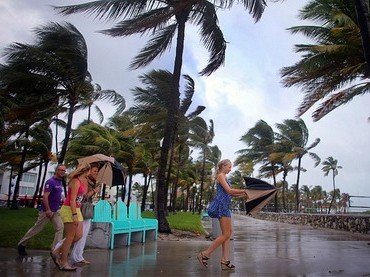
Hurricane Sandy could merge with a winter storm to create what they have dubbed “Frankenstorm” as it churns towards the US, forecasters warn.
Sandy has weakened to a category one hurricane, but is still packing maximum sustained winds of 75 mph (120 km/h).
Hurricane Sandy reportedly caused up to 40 deaths as it tore through the Caribbean on Thursday and Friday.
The storm is projected to hit the US late on Monday, a week before the presidential election.
States of emergency have been declared in Maryland, New York, Pennsylvania, Virginia, Washington and a coastal county in North Carolina.
The US Navy base in Norfolk, Virginia was reportedly sending a whole fleet of ships out to sea to avoid the storm.
At 23:00 EDT, the hurricane was moving north over the Bahamas at about 7 mph, some 400 miles (630 km) south-east of Charleston in South Carolina, according to the National Hurricane Center (NHC).
Hurricane-strength winds were being experienced 70 miles from the centre of the storm, which was expected to slowly weaken during the weekend, reported the NHC.
American meteorologists expect a combination of high winds, heavy rain and extreme tides, as well as snow in some areas.
Up to 10 in (25 cm) of rain, 2ft of snow and extreme storm surges are forecast.
“It’s going to be a long-lasting event, two to three days of impact for a lot of people,” said James Franklin, head forecaster at the NHC.

Hurricane Sandy is expected to strike the US late on Monday or early Tuesday somewhere along the US east coast, a day before Halloween and a week before millions of Americans go to the polls to choose a next president.
It could make landfall anywhere between Virginia, Maryland or Delaware up through New York or southern New England.
In New York City, officials are already considering closing down mass transit before the storm hits.
Republican presidential candidate Mitt Romney cancelled an event scheduled for Sunday in Virginia, a key election state, because of the weather, said an aide.
Earlier on Friday, the White House declined to speculate on whether Hurricane Sandy would affect President Barack Obama’s campaign plans, saying the storm’s path was still uncertain.
Forecasters say Hurricane Sandy is similar to another late October storm – when several weather systems, including a hurricane, combined along the US Atlantic coast in 1991, leading to what was dubbed “the Perfect Storm”.
Jeff Masters, meteorology director at Weather Underground, estimated there could be more than $1 billion in damages from Hurricane Sandy.
On Thursday, Hurricane Sandy caused a storm surge leading to severe flooding along Cuba’s south-eastern coastline.
Civil emergency authorities said 11 people had died as the storm lashed the island – nine of those in Santiago province and two in Guantanamo province, despite Cuba’s well-rehearsed hurricane preparations. Most victims were killed by falling trees or collapsing buildings.
“The hurricane was very big. I have never seen anything like it in my 54 years,” said Santiago resident Reinaldo Rivas.
Elsewhere, 20 deaths were reported in Haiti – where much of the infrastructure remains in a poor condition following a massive earthquake in 2010.
More than 1,000 people sought refuge in shelters there, as Hurricane Sandy caused widespread power outages, flooded streets and damaged buildings.
Four fatalities were reported across the Dominican Republic, Jamaica and the Bahamas.
[youtube WS8kD5H8yHU]